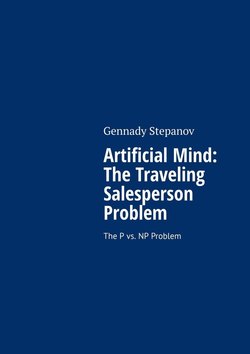Читать книгу Artificial Mind: The Traveling Salesperson Problem. The P vs. NP Problem - Gennady Stepanov - Страница 2
Introduction
ОглавлениеThis book, which I offer to inquisitive readers, deals with the algorithm-theory problem of enumeration considered in discrete mathematics.
This book is part of a series that describes an artificial-mind model I developed based on the philosophy of the Kantian apriorism. This model imitates the human mind and human thinking.
The question of whether the complexity classes of P and NP problems are equal, also known as the enumeration problem, has been the central open problem in algorithm theory for more than four decades.
An affirmative answer to that question would mean it is theoretically possible to solve many complex problems far faster than they can be solved today.
The lack of a solution to the central problem of modern discrete mathematics inhibits the development of not only discrete mathematics but of mathematics as a whole.
This applies to many areas of study of mathematical structures in algebra, topology, geometry, and suchlike fields.
As with other enumeration problems, a feature of the traveling salesperson problem (TSP) is that it is fairly easy to obtain its solution. The hardest part is proving the optimal solution (finding the best solution).
This book considers a seamless method for exactly solving combinatorial-optimization problems (I call it an effective combinatorial-optimization method). I developed the method using, as an example, the TSP, an NP-hard problem in combinatorial optimization.
Exact, effective methods for solving NP problems are yet unknown.
In applying my effective combinatorial-optimization method, I was able to find an indirect indicator that the resulting solution is optimal.
It has been proved that a method that allows you to effectively solve an NP problem can also be applied to solving other NP problems.
My research yielded a certain relationship for the TSP. This relationship is natural, objective, and scientifically novel.
My effective combinatorial-optimization method is based on this relationship and uses the indirect criterion I found for determining the best solution. The method is also applicable to solving a variety of other NP problems.
I claim I might have solved the central problem of modern discrete mathematics – the P versus NP problem. P = NP.
This book opens a series devoted to developing an anthropomorphic artificial mind as a new line of research different from artificial intelligence (AI), whether strong or weak. This series of my books offers fundamentally novel insights and is the only such series in the scientific world.
